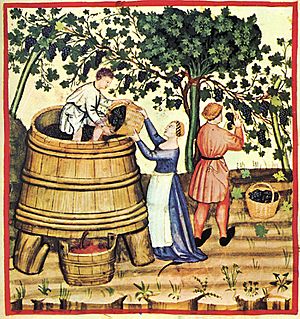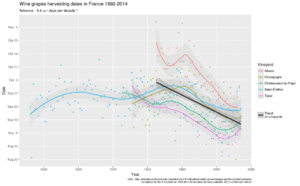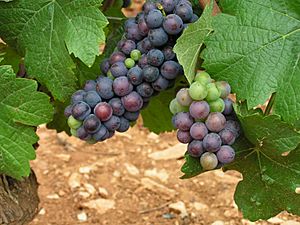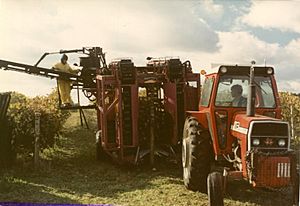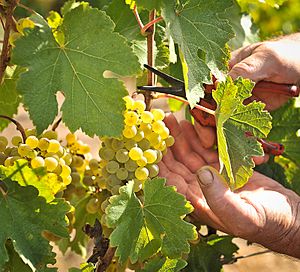Harvest (wine) facts for kids
The harvesting of wine grapes is a super important step in making wine. This process is also called the vintage. Winemakers decide when to pick grapes mainly by how ripe they are. They check the levels of sugar and acid in the grapes. The kind of wine they want to make helps them decide the best time to pick.
Weather also plays a big role. Too much heat, rain, hail, or frost can hurt the grapes. This bad weather can also cause plant diseases. Besides choosing the right time, winemakers also decide how to pick the grapes. They can use people to pick by hand or big machines. In the Northern Hemisphere, grapes are usually picked between August and October. In the Southern Hemisphere, it's typically from February to April. Because of different climates and grape types, grapes can be harvested almost any month somewhere in the world!
Contents
When are grapes harvested?
Most places that grow wine grapes are found between 30° and 50° latitude. This is in the temperate zones of both the Northern and Southern Hemispheres. Warmer places closer to the equator usually harvest earlier.
In the Northern Hemisphere, some grapes are picked as early as July. For example, in California, grapes for sparkling wine are picked in late July. This helps the wine keep its fresh taste. Most harvesting in the Northern Hemisphere happens from late August to early October. Some special grapes for "late harvest" wines are picked even later in the autumn. In countries like Germany and Canada, grapes for "ice wine" can be picked as late as January!
In the Southern Hemisphere, harvesting can start in January. This happens in warm places like New South Wales, Australia. Most grapes in the Southern Hemisphere are picked between February and April. Some cooler places, like Central Otago in New Zealand, pick late harvest grapes in June.
Recently, climate change has shifted when grapes are picked in some areas. Warmer weather might make it harder to keep the same wine quality in some vineyards. However, it could also make other regions better for growing balanced grapes.
How do winemakers know grapes are ready?
For a long time, winemakers tasted grapes to see if they were ripe. They also looked at the sugar and acid levels. Today, winemakers use special tools. A refractometer measures how much sugar is in the grapes. They also do tests to find out the total amount of acid.
More recently, winemakers also focus on the "physiological" ripeness of the grape. This means checking other natural compounds, like tannins. Tannins are what make wine taste a bit dry or bitter. Right now, tasting is the only way to know if tannins are ripe enough. It takes a lot of practice to do this well. Scientists are still learning how tannins ripen. They think small, bitter tannins change into larger, softer ones as the grape gets riper.
Picking grapes with machines
Using machines versus hand picking is a big discussion in the wine world. Mechanical harvesters became popular in the 1960s. Many vineyards now use them for different reasons. These include saving money, needing fewer workers, and making wine in certain ways. In Australia, for example, there aren't enough workers, so machines are very important.
A mechanical grape harvester works by gently shaking the vine. This makes the grapes fall onto a conveyor belt. The belt then carries the grapes into a bin. Newer machines are much better at picking out only the grapes. They can avoid mud or leaves. But some machines still struggle to tell the difference between good grapes and bad ones. These bad grapes then need to be sorted out later.
Another problem with machines is that they can sometimes break the grape skins. This can change the color of the juice, which is not good for white or sparkling wines. Broken skins can also cause the juice to mix with air, which can make the wine lose some of its nice smells.
One great thing about machines is their lower cost. A harvester can work all day and night. It can pick 80 to 200 tons of grapes. A person can only pick about 1 to 2 tons. In hot places, it's important to pick grapes quickly or at night when it's cooler. Machines are very good at doing this.
Picking grapes by hand
Even though it costs more, some wineries prefer hand picking. The main benefit is that human workers can choose only the healthy grape bunches. They also handle the grapes more gently. For some special dessert wines, like Sauternes, individual berries need to be picked. This can only be done by hand.
In places with very steep hills, like the Mosel region, machines simply cannot be used. So, all the grapes must be picked by hand. Many workers during harvest time are people who travel for work. Local students and temporary workers also help. In California, many workers in the wine industry come from Mexico.
See also
 In Spanish: Vendimia para niños
In Spanish: Vendimia para niños


